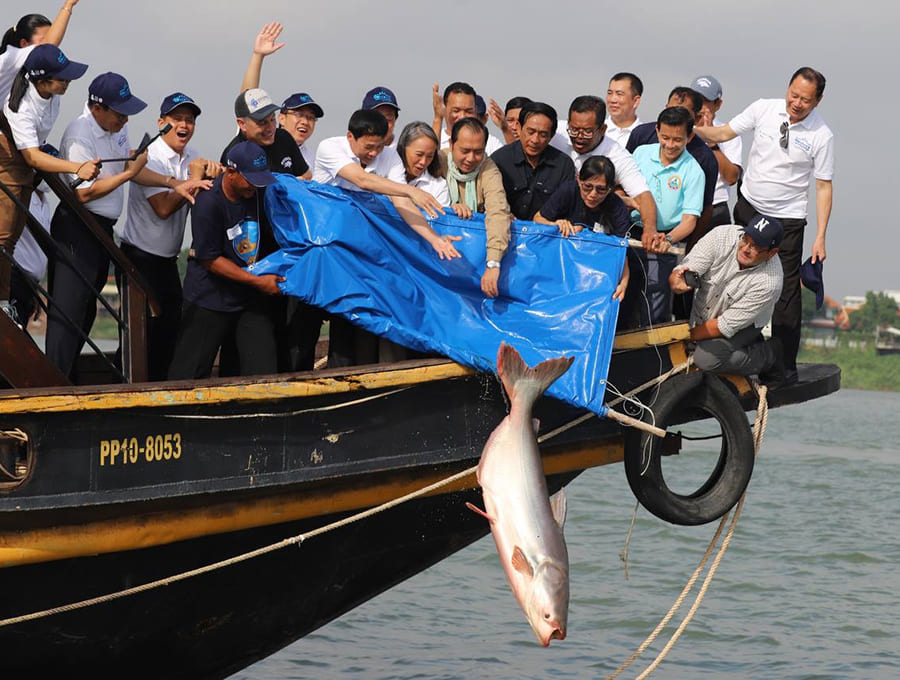Two Mekong giant catfish called "trey riech" (for royal fish) in Khmer, a critically endangered species, were released in a ceremony at the confluence of Cambodia’s Mekong and Tonle Sap rivers. The ceremony highlighted a decades-long partnership to conserve these unique ecosystems, rich in biodiversity and with a migration of fishes that rival the animal migrations across the Serengeti plains of Africa.
The ceremonial release of these and other important fish was attended by about 100 people in five boats. On the boats were a group of University of Nevada, Reno officials, faculty and supporters who traveled in January to Cambodia to further develop the Wonders of the Mekong project, an international collaboration based out of the University’s Global Water Center to research, educate and advise on water and biodiversity issues in the Mekong River basin in Cambodia.
The University group was led by Zeb Hogan, College of Science fish biologist and project lead of the University’s USAID-funded Wonders of the Mekong project and Sudeep Chandra, Director of the Global Water Center and Ozmen Institute for Global Studies. They were also there for a policy roundtable, to sign a Memorandum of Understanding with the Royal University of Agriculture and the grand opening of their new limnology (study of of inland waters) laboratory.
The release of the two giant catfish and two other species of ecologically important fish underscored the plight of freshwater fish species whose populations have decreased significantly in recent decades due to changes in seasonal river flows from dams and changing climate.
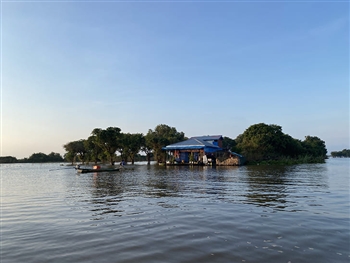
Presiding over the ceremonial events were H.E. Has Sareth, Cambodia’s Secretary of State of the Ministry of Agriculture, Forestry and Fisheries; and Hanh Nguyen, acting mission director of the United States Agency for International Development.
"The release of these fish, together with parallel efforts to protect wild fish and their habitats, represent a significant contribution to species survival,” Hogan said. “The continued efforts highlight our successful partnerships with the Cambodian government, NGO’s, community partners and the Royal University of Agriculture, Cambodia's top institute of higher education for fisheries research.”
Scientists hope their efforts will lead to more concerted and coordinated conservation action, including greater outreach to communities living along the Tonle Sap and Mekong rivers. The passengers who attended the fish release event in the middle of the rivers included students, government officials, media representatives, fishery officials and volunteers. Also in attendance, University of Nevada, Reno President Brian Sandoval engaged with government officials to showcase the University’s commitment to building capacity and education within Cambodia to tackle issues related to natural resources management.
“It was an honor and privilege to participate in the fish release with the Cambodian government and academic representatives,” Sandoval said. “To see the years of effort in raising the fish come to fruition with this ceremony, and realizing how the University’s historic partnerships will make a difference in helping to save these endangered species, and ultimately the health of the river and helping the communities along the river – it’s just amazing.”
The Mekong giant catfish is one the Earth's largest freshwater fish and is revered by communities along the river. Reaching a maximum size of 10 feet in length and 660 pounds, the species is only found in the Mekong River. The river stretches 2,700 miles from southeastern China along the border of Myanmar and Lao PDR and then through Thailand, Cambodia and Vietnam before draining into the South China Sea. The giant catfish were once abundant in Thailand and Lao PDR, but populations have declined significantly. In Cambodia, small numbers are still caught from the Tonle Sap River bagnet (or dai) fishery as well as from the Cambodian portion of the Mekong River.
“It is essential that we work together to save and conserve ecologically important and critically endangered fish species, like the Mekong giant catfish, in order to keep the Mekong River healthy,” USAID’s Nguyen said. “This will conserve natural ecosystems to support communities, wildlife and economic activity across Cambodia.”
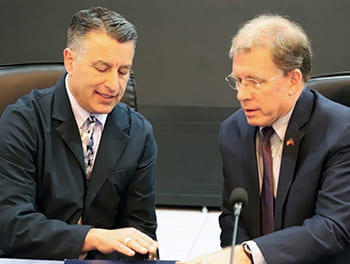
Melanie Duckworth, associate dean of the College of Science accompanied the University delegation and supporters from the community.
“As a part of this visit to Cambodia, we toured national museums and other historic sites,” she said. “But the thing that was most impactful was actually engaging with the river and engaging with the communities who live on and derive their livelihood from the river. It was inspiring to see the events so well attended by government officials, ministers, deputy ministers and others engaged in conservation of the river.”
Hogan said they also traveled with Nevada community members who have supported the University of Nevada, Reno and were interested to learn more about the university's international activities and global impact. The team toured critical habitats like flooded forests and deep pools along the river.
Susan and Gary Clemons, University supporters along on the trip, had thoughts and impressions similar to Duckworth’s of the work and impacts the Wonders project is making on communities that rely on the river.
“My expedition highlights were each time we explored by small boat,” Susan Clemons said. “Seeing a floating community complete with homes each with adjacent floating gardens; merchants, medical facilities and a floating school with a connected floating play yard; the boat ride through the flooded forest near Stung Treng followed by a sunset float down the Mekong through deep pools, small rapids and whirlpools was another highlight.”
The group took an unplanned boat ride to a fishery north of Phnom Penh to witness and release an endangered Giant Barb that had just been caught by a fishing family. As part of the Wonders project, the scientists work together with the fishermen to protect large endangered species. The fishermen notify and allow the scientists to document the catch and release and the community releases these critically endangered fish to aid in their conservation.
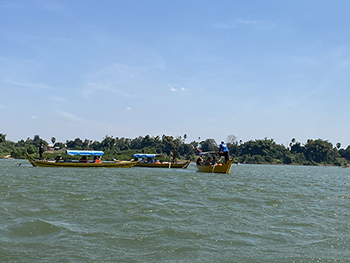
“It’s awe-inspiring to see firsthand how the University of Nevada, Reno has nurtured relationships with Cambodian fishermen, professors, students and agencies to identify and protect these critically endangered species,” Clemons said.
King of the River
The Mekong giant catfish that were released weighed about 100 pounds and measured more than five feet in length. They were raised in a farmer's pond after being harvested from the wild as tiny fry. Among other fish released were giant barb, a critically endangered carp species that is known as the “national fish of Cambodia,” and striped catfish, a highly migratory fish that was once a staple food in the region but has seen sharp declines and is now classified as endangered.
“Over the years the Cambodian Department of Fisheries has released thousands of endangered fish as part of conservation efforts,” Hogan said. “It’s still amazing to watch the fish as they enter the river – and the feeling of hope and excitement. For many years, we've worked together to protect the fish, the aquatic environment and and all the communities who rely on it.”
This latest fish release is particularly significant because it took place during the natural mass migration of fish out of the Tonle Sap floodplain and into the Mekong River. More than 100 different species of fish, including many of the river's largest, make this migration as an essential part of their ecology.
“We have been able to track the fish with tags that can be picked up by sounding devices and we will see if they migrate along with the wild fish,” Hogan said. “We’ve had success tracking these big fish before and can learn a lot from these types of efforts.”
Scientists understand that the migration of these endangered fish and hundreds of more species that - in terms of sheer biomass - rival the migration of animals across the Serengeti plains. These migrations and growth into the flooded forests and grasslands supports the largest inland fishery in the world, producing more than two million tons of fish annually.
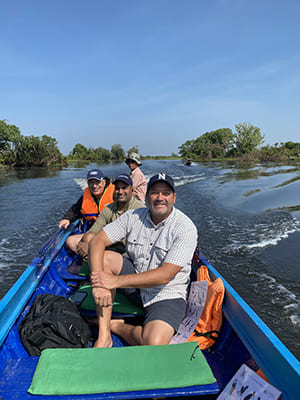
Mekong River species are among the largest, most unique and most threatened freshwater megafauna on the planet. The river is home to more giant fish species than any other river on Earth, and yet these fish are struggling for their survival. The largest species of fish – the river giant catfish, Pangasius catfish, giant carp and giant freshwater stingray – are all endangered. Their dwindling populations are an early warning sign of indiscriminate fishing practices and unsustainable river basin development.
"We want to encourage policies that enable this important resource to thrive in the wild," Cambodian Secretary of State Has Sareth said.
Dr. Heng Kong, Director of the Inland Fisheries Research and Development Institute of Cambodian Fisheries Administration, said: "IFReDI strongly supports endangered fish conservation efforts like this fish release because it promotes public awareness and participation. IFReDI is committed to research that leads to science-based polices and solutions for the long-term conservation of Mekong fishes."
Project partners
The Wonders of the Mekong project has been working with its Cambodian partners since 2017. Project partners aim to increase knowledge about the importance of the Mekong River and encourage sustainable use of Cambodia's aquatic resources through applied research, capacity building and communication with many research and conservation projects.
Wonders of the Mekong works with The Cambodian Ministry of Agriculture, Forestry and Fisheries, through the Cambodian Fisheries Administration and the Inland Fisheries Research and Development Institute to study and conserve endangered fish and altered forests and river and lake ecosystems. The research has contributed to the survival of endangered species and generated important scientific information such as population numbers, critical habitat and migration corridors.
A dozen early-career scientists have been trained through the Wonders project and dozens of publications in peer-reviewed journals have been produced over the short duration of the project providing scientifically supported information that can help create new policies to protect the Mekong River, its biodiversity and watershed.
“Through the Wonders of the Mekong project, the University supports one of the largest cohorts of freshwater fisheries biologists in Southeast Asia,” Chandra said. “Most of this group is based at the Royal University of Agriculture, as well as the Royal University of Phnom Penh and the Institute of Technology of Cambodia. Part of our reason for being in Cambodia this week is to finalize a Memorandum of Understanding with RUA.”
Chandra and Hogan are both faculty in the College of Science and Department of Biology. At the Royal University of Agriculture, they co-advise five Cambodian masters students, six doctoral students and three post-doctoral scholars through the Wonders project. They also help manage several RUA-lead research activities.
“This Wonders of the Mekong program is a prime example of how the University reaches out around the globe, with collaborations and ongoing research on just about every continent,” Sandoval said. “Our new five-year strategic plan emphasizes international research such as this – it illustrates the strategic plan in action with globally significant work.
“This is an incredible effort being taken to protect the Mekong River and its wonders; and the partnership between the University, USAID and the Fisheries Administration – among others – to bring these incredible aquatic animals back from the brink of extinction and to work on sustainable solutions is amazing – everyone benefits from international exchange.”
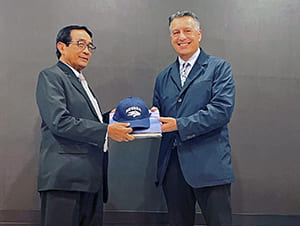
Memorandum of Understanding
The signing of the MOU enables the relationship between the two institutions to continue to grow, outlining several strategic areas of collaboration. It formalizes the partnership between the two universities and makes it easier to organize and fund future collaborative research, education and cultural exchanges.
The MOU recognizes the future potential of collaborative work, including plans to establish a field station for learning and research along the river, co-development of curriculum around water issues, countrywide environmental monitoring to improve aquatic ecosystem health and research in support of sustainable development that will grow Cambodia's economy and protect biodiversity
The Cambodian research collaboration has already been very productive, with more than 10 active research projects throughout the country on topics ranging from environmental health, water quality, fisheries, fish ecology and water management.
“We also coordinate research activities and exchanges between RUA scientists and students and American scientists and students, including research on environmental DNA, rapid water quality assessment, acoustic monitoring of fisheries health and telemetry studies to better understand fish migration,” Hogan said. “These collaborations have resulted in over a dozen papers in open access scientific journals and contribute to science-based management in Cambodia.”
Wonders of the Mekong has also established a limnology laboratory and a research fish collection and fish display for outreach purposes at the Inland Fisheries Research and Development Institute, where the Wonders program maintains an office.
Overall the trip brought together the main partners on the Wonders project: USAID/U.S. Embassy, Cambodian institutions, and University of Nevada, Reno; and the Ambassador and two Cambodian Secretaries of State and the Director General of the Fisheries Administration participated in many of the project activities, including the grand opening of the new limnology laboratory.
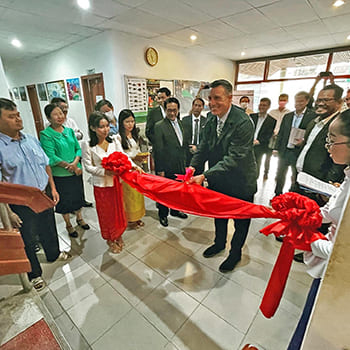
The limnology laboratory was developed through a partnership with the Cambodian government and the Royal University of Phnom Penh to study and improve water quality, river health and aquatic ecosystems in Cambodia. It is equipped with the latest technology and is undertaking a nationwide rapid water quality assessment, while a project in the fish collection and teaching room has identified, organized, and sequenced the mitochondrial genome of several species of critically endangered fish, including one that was presumed extinct for almost 20 years.
College of Science motto is "Live a Life of Discovery"
Louis Lavrich, one of the University supporters on the trip, also attended the grand opening of the lab.
“I think the College’s motto fits this trip perfectly, as this trip was an eye opener and will change my life forever, due to all the things I discovered and learned,” Lavrich said. “One of the biggest learning experiences was the opening ceremony for the limnology lab and the MOU between the Royal University of Agriculture and the University of Nevada, Reno.
“Seeing these moments, and watching as rooms filled with committed people sharing history and life changing moments, really opened my eyes as to the inner workings of what goes on behind the scenes of all of the scientifically important things that help shape the world. It was so amazing to see people from all different backgrounds uniting together in collaboration for a joint cause and to try to collaboratively solve a national issue.”
The Mekong region is characterized by extraordinary natural and human capital: productive environments that support bountiful fisheries and agriculture, rich biodiversity and a climate connected to one of the largest rivers on Earth - sustained by seasonal flows, supporting livelihoods and river life. The people of the region play an essential role in the future economic development and environmental health of the region, and as such efforts such as the Wonders of the Mekong project build important connections between Asia and the United States.
The collaborative projects on fisheries and endangered freshwater fish species, have led to improved environmental safeguards along the Tonle Sap Lake and the rivers of northern Cambodia. Chea Seila, Cambodia program manager for Wonders of the Mekong, said that conservation of endangered species is an important indicator of the health of the river.
"The Mekong giant catfish is symbolic of the integrity of the Mekong River,” she said. “By protecting this giant fish, we also protect fisheries, environmental health and Cambodia's natural resources and economy. It is time to learn and understand about our fishes in our country, especially endangered species so that we don't lose them forever."
